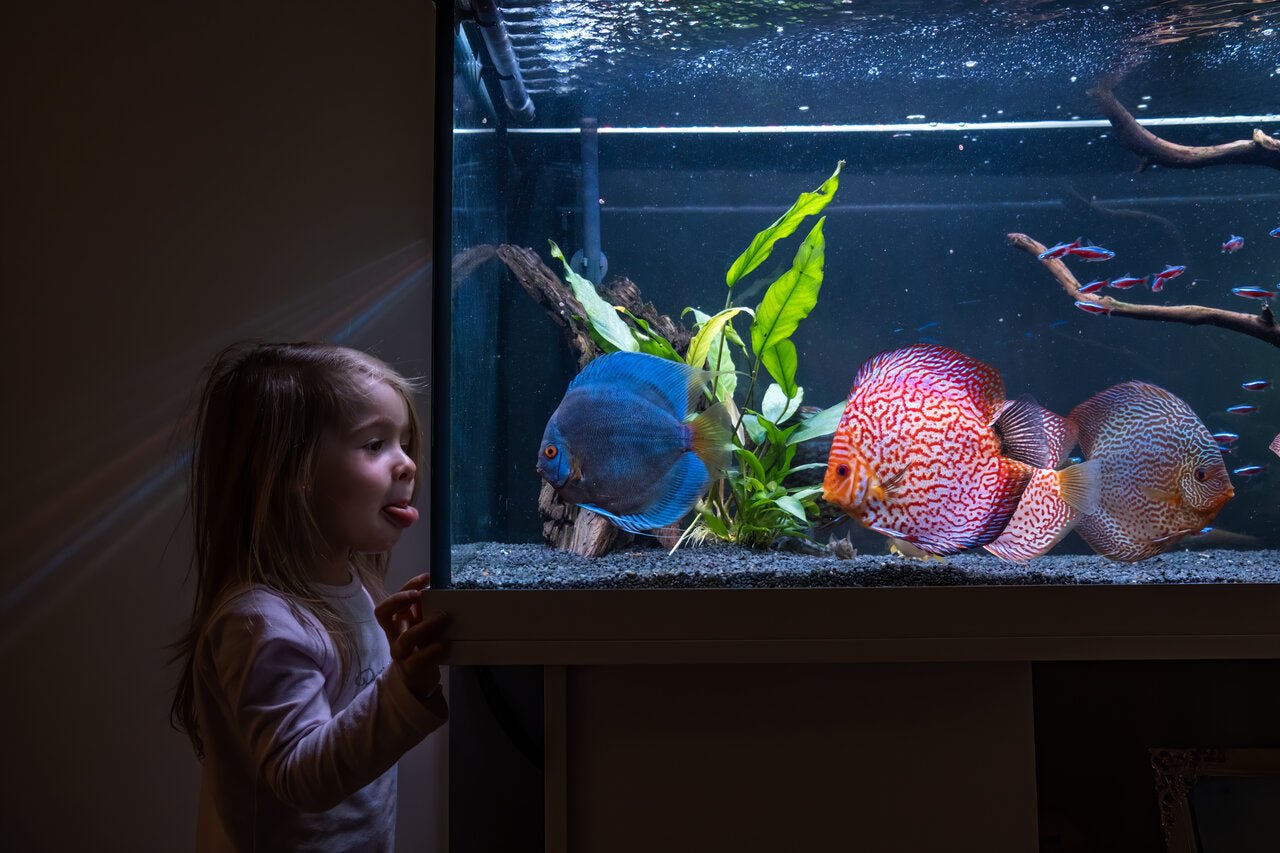Imagine entering an art gallery and discovering all the exquisite masterpieces are shrouded in darkness, their colours and details obscured, their delicate nuances unappreciated. This is precisely the situation when an aquarium's lighting system fails to match the needs of its living inhabitants or to provide an optimal display for the viewer. As one of the UK's largest aquatics specialists, Perfect Aquatics recognises the profound impact of aquarium lighting on aquatic life, plant growth, and overall aesthetic appeal. With this essential guide, discover the importance of selecting the perfect aquarium lighting system and embrace the power of illumination to enrich, enhance, and transform your undersea landscape into a mesmerising aquatic tapestry.
A Spectrum of Possibilities: Types of Aquarium Lighting
To navigate the world of aquarium lighting effectively, begin by acquainting yourself with the various types available, and the distinct advantages and drawbacks they offer:
- Fluorescent Tubes: A long-standing favourite in the aquarium industry, fluorescent tubes come in a wide range of spectrums and wattages. Typically more energy-efficient than incandescent bulbs, they provide suitable lighting for freshwater planted tanks and low-to-medium light-demanding marine setups. However, note that their output decreases over time, necessitating regular replacement to maintain optimal performance.
- Compact Fluorescent Lights (CFL): As a more compact alternative to traditional fluorescent tubes, these spiral-shaped bulbs offer similar lighting capabilities and performance, with the added advantage of being easier to install in tight spaces.
- Metal Halide Lamps: Once the go-to choice for reef aquariums requiring intense, high-output lighting, metal halides boast excellent colour rendition and spectral output. Nonetheless, they have fallen out of favour due to their heat generation, high power consumption, and the rise of LED lighting.
- Light Emitting Diode (LED) Lighting: LED lights have surged in popularity owing to their energy efficiency, longevity, and controllability. With options for dimming, spectral adjustment, and programmable timers, this highly adaptable lighting solution can be tailored to suit the needs of various aquatic environments, from freshwater planted tanks to coral-rich marine systems.
The Intensity Equation: Balancing the Light Output
When choosing your aquarium lighting, understanding the concept of intensity is crucial. In essence, intensity refers to the amount of light energy emitted by the lighting system, impacting critical biological processes such as photosynthesis in plants and corals. Consider the following aspects when evaluating the intensity requirements of your aquatic inhabitants:
- Aquatic Plants: Light-demanding plants typically require higher intensity lighting, while low light-adapted plants fare well under more moderate illumination. Striking the right balance ensures that all plants thrive and does not encourage unwanted algae growth.
- Coral Reefs: Coral species, especially photosynthetic corals housing symbiotic algae, have specific intensity requirements for optimal growth and health. Ensuring adequate light penetration and distribution in your reef aquarium is vital for the coral's success.
- Fish Behaviour: While fishes are less directly affected by lighting intensity, an environment that is too bright or dark can cause stress and behavioural changes. Observe your fish and adjust the lighting accordingly to facilitate their comfort and well-being.
Colour Temperature: Aquarium Lighting's Chromatic Dimension
Colour temperature, measured in Kelvin (K), is a fundamental attribute of aquarium lighting that affects both the aesthetic and biological aspects of your underwater environment:
- Plant Growth: Plants utilize specific wavelengths of light within the Photosynthetically Active Radiation (PAR) range for growth. Colour temperature influences the spectral composition of light and, subsequently, the availability of these essential wavelengths. Aim for a colour temperature in the range of 5,000K - 7,000K for freshwater planted tanks to encourage healthy growth.
- Marine Coral Development: Photosynthetic corals also rely on particular light wavelengths, typically within the blue range of the spectrum. Electing for a colour temperature around 10,000K - 20,000K can optimise coral growth and simultaneously display their vibrant colours impressively.
- Aesthetic Appeal: Colour temperature significantly impacts the visual appearance of your aquarium, affecting colour rendition and perceived depth. Experiment with different colour temperatures to achieve a captivating display that highlights the natural beauty of your aquatic life.
Creative Lighting Design: Crafting your Aquatic Ambience
With a solid foundation in the principles and elements of aquarium lighting, unleash your creativity and harness the power of illumination to design a vibrant, alluring underwater environment:
- Light Positioning: Experiment with the positioning and angles of your lighting system to create depth, shadows, and focal points within your aquarium landscape.
- Layered Lighting: Combine multiple light sources with differing colour temperatures and intensities, harmoniously blending them to accentuate the natural hues of your fish, plants, and corals.
- Lighting Enhancements: Incorporate LED accent lights, moonlights, or colour-changing bulbs to add extra dimension, transforming your aquatic environment into a dynamic, immersive space.
Conclusion
Embarking on the journey of aquarium lighting selection and design can feel overwhelming; however, equipped with the knowledge of lighting types, intensity, colour temperature, and creative customisation, you hold the power to transform your underwater world into a radiant sanctuary of thriving aquatic life.
Partner with Perfect Aquatics to navigate the mysteries of illumination, enriching your aquarium landscape with the perfect selection of lighting systems, and unlocking the limitless potential of your vibrant aquatic universe. With insight, expertise, and a shared passion for aquatics, together, we can shed light on the path towards a brighter future. Check out our aquatics store in the UK now.

